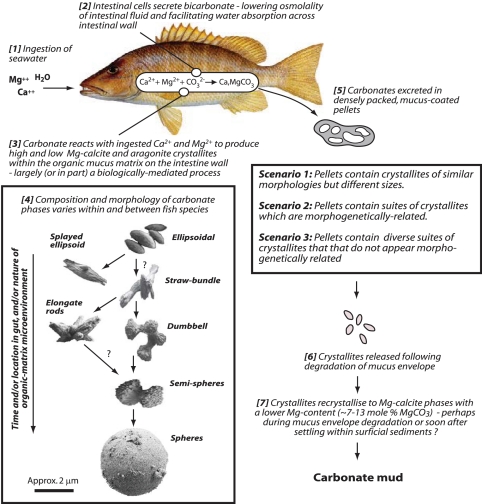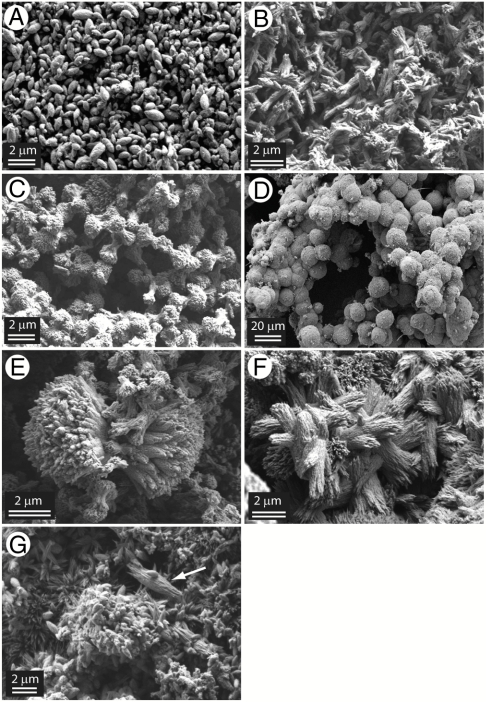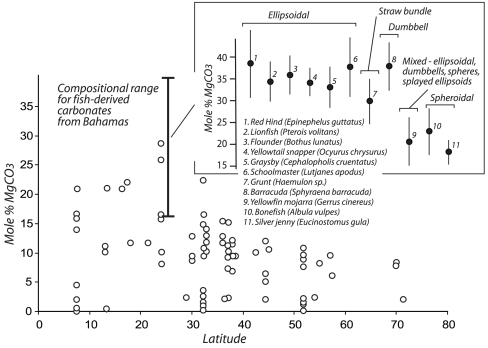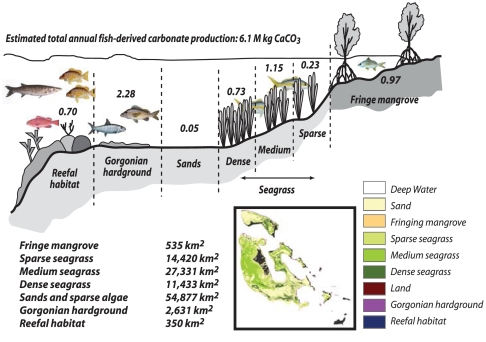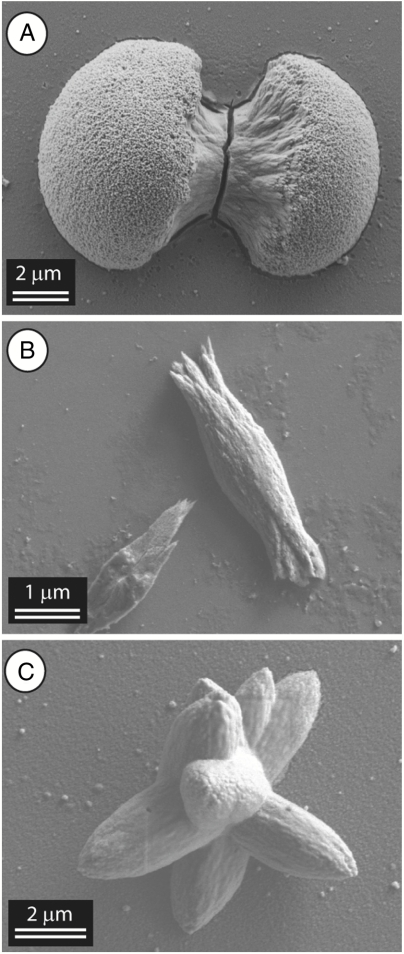Abstract
Carbonate mud is a major constituent of recent marine carbonate sediments and of ancient limestones, which contain unique records of changes in ocean chemistry and climate shifts in the geological past. However, the origin of carbonate mud is controversial and often problematic to resolve. Here we show that tropical marine fish produce and excrete various forms of precipitated (nonskeletal) calcium carbonate from their guts (“low” and “high” Mg-calcite and aragonite), but that very fine-grained (mostly < 2 μm) high Mg-calcite crystallites (i.e.,  MgCO3) are their dominant excretory product. Crystallites from fish are morphologically diverse and species-specific, but all are unique relative to previously known biogenic and abiotic sources of carbonate within open marine systems. Using site specific fish biomass and carbonate excretion rate data we estimate that fish produce ∼6.1 × 106 kg CaCO3/year across the Bahamian archipelago, all as mud-grade (the < 63 μm fraction) carbonate and thus as a potential sediment constituent. Estimated contributions from fish to total carbonate mud production average ∼14% overall, and exceed 70% in specific habitats. Critically, we also document the widespread presence of these distinctive fish-derived carbonates in the finest sediment fractions from all habitat types in the Bahamas, demonstrating that these carbonates have direct relevance to contemporary carbonate sediment budgets. Fish thus represent a hitherto unrecognized but significant source of fine-grained carbonate sediment, the discovery of which has direct application to the conceptual ideas of how marine carbonate factories function both today and in the past.
MgCO3) are their dominant excretory product. Crystallites from fish are morphologically diverse and species-specific, but all are unique relative to previously known biogenic and abiotic sources of carbonate within open marine systems. Using site specific fish biomass and carbonate excretion rate data we estimate that fish produce ∼6.1 × 106 kg CaCO3/year across the Bahamian archipelago, all as mud-grade (the < 63 μm fraction) carbonate and thus as a potential sediment constituent. Estimated contributions from fish to total carbonate mud production average ∼14% overall, and exceed 70% in specific habitats. Critically, we also document the widespread presence of these distinctive fish-derived carbonates in the finest sediment fractions from all habitat types in the Bahamas, demonstrating that these carbonates have direct relevance to contemporary carbonate sediment budgets. Fish thus represent a hitherto unrecognized but significant source of fine-grained carbonate sediment, the discovery of which has direct application to the conceptual ideas of how marine carbonate factories function both today and in the past.
Keywords: marine teleost, fish intestine, carbonate production
Marine carbonates contain unique records of changes in ocean chemistry, biogeochemical cycling, and benthic and pelagic ecology (1), and therefore provide vital information on climate shifts in the geological past. A distinctive and often volumetrically important component of these sediments is carbonate mud (the < 63 μm sediment fraction). However, the origins of both aragonitic and Mg-calcite carbonate muds remains a topic of long-standing debate (2, 3). Indeed, where attempts have been made to quantify sources of the fine sediment fraction a high proportion remains of unknown origin (e.g., up to 40% in Bahamian sediments and between 28 and 36% in Belize lagoon sediments) (4, 5). This problem arises in part because, with the exception of inorganic carbonate precipitation (e.g., the carbonate “whiting” controversy) (3, 6–8), the processes of carbonate mud production necessarily invoke the degradation of larger bioclasts (skeletal fragments of marine organisms) to produce mud-grade carbonate, and/or grain recrystallization to produce high Mg-calcite muds (9–11). Thus attempts to determine primary mud sources and production budgets are often hampered because of grain obliteration. The mineralogical composition of the mud fraction of modern tropical carbonate sediment is also very variable between settings: in some environments the finest sediment fractions are predominantly aragonite (12, 13), but high Mg-calcite can account for in excess of 40% of the mud fraction in many settings (14–16). Ultimately variable admixtures of both aragonite and Mg-calcite mud-grade carbonate occur and thus budgetary considerations need to accommodate production from a range of potential sources. This issue has important geo-environmental implications because carbonate muds are major constituents of limestones and are volumetrically important in most modern shallow marine carbonate environments (17). Furthermore, the presence of Mg-calcite muds in marine carbonates is considered critical to preserving primary sediment textures and fabrics (15), thus influencing sediment porosity and permeability which are of critical importance to fluid flow in limestone sequences. Mud production in ancient limestones has proven particularly perplexing because evidence is often lacking for the presence of species that are regarded as key modern mud producers (especially the calcareous green algae) (18).
Recent observations of carbonate crystals growing within, and being continually excreted from, the intestines of temperate fish species (19) lead us to speculate that such crystals could represent a hitherto unrecognized source of mud-grade carbonate in shallow tropical marine environments. In these shallow marine environments carbonate production rates are typically high and preservation potential is good because of high carbonate saturation states in the overlying waters. The process by which fish precipitate carbonate crystals within their guts has been documented in some detail (19–22) and occurs within the teleosts (bony fish) that dominate the marine fish fauna. Briefly, precipitation occurs as a by-product of the osmoregulatory requirement of teleosts to continuously drink Ca- and Mg-rich seawater. Subsequent intestinal bicarbonate secretion generates exceptionally high concentrations of  (50–100 mM) and very high pH values (up to 9.2) which leads to the alkaline precipitation of calcium and magnesium within ingested seawater as insoluble carbonates along the intestine (19–24; Fig. 1). Carbonate precipitation is believed to occur within the mucus that is secreted along the entire length of the intestinal lumen (21, 23, 24), and carbonates are subsequently excreted within mucus-coated pellets. Following their excretion the rapid degradation of the organic mucus matrix is assumed to release inorganic crystals into the water column (19). Whilst the physiological processes driving fish carbonate production are thus increasingly well understood, the morphological characteristics of such carbonates and their sedimentological significance have never been considered.
(50–100 mM) and very high pH values (up to 9.2) which leads to the alkaline precipitation of calcium and magnesium within ingested seawater as insoluble carbonates along the intestine (19–24; Fig. 1). Carbonate precipitation is believed to occur within the mucus that is secreted along the entire length of the intestinal lumen (21, 23, 24), and carbonates are subsequently excreted within mucus-coated pellets. Following their excretion the rapid degradation of the organic mucus matrix is assumed to release inorganic crystals into the water column (19). Whilst the physiological processes driving fish carbonate production are thus increasingly well understood, the morphological characteristics of such carbonates and their sedimentological significance have never been considered.
Fig. 1.
Fish carbonate production and precipitation products. Schematic diagram illustrating the processes associated with carbonate precipitation within the intestines of fish and the dominant crystallite morphologies identified in this study to be produced by tropical fish species.
Results and Discussion
In order to study the morphological and compositional characteristics of carbonates produced by tropical marine fish, carbonate samples were obtained from 11 common fish species (see SI Appendix) collected from shallow water sites on the Eleuthera Bank, Bahamas (SI Appendix: Fig. S1). This area was selected for study as it combines warm, shallow waters that are supersaturated with respect to CaCO3, and comprises a range of typical carbonate platform sedimentary environments. The mucus-coated pellets excreted from fish guts that contain the carbonate precipitates vary in shape and size with fish species (SI Appendix: Fig. S2), but subsequent degradation of the organic mucus phase in the laboratory, through dilute hypochlorite treatments (see SI Appendix), releases inorganic carbonate pellets up to 2 mm in size. Each pellet comprises huge numbers of individual crystallites and polycrystalline precipitates (in most cases estimated at > 106 per pellet; SI Appendix: Fig. S2), along with an amorphous “matrix” of finer (< 0.25 μm) carbonate. When subjected to even gentle ultrasonic agitation, rapid pellet disaggregation occurs, resulting in the release of large volumes of fine-grained crystallites (SI Appendix: Fig. S3).
Different fish species produce different types of pellet (in terms of size, shape, and density of precipitate packing) that consist of crystallites and polycrystalline aggregates of varying size and morphology (Fig. 1 and SI Appendix: Figs. S4–S14), although most are < 2 μm in size. Despite the differences between species, four particularly common morphologies occur from the range of fish examined: ellipsoidal; straw bundle-shaped; dumbbell-shaped; and spheroidal (Fig. 2 A–D). In addition, several less common morphologies occur including: (i) semispherical polycrystalline aggregates (Fig. 2E); (ii) polycrystalline aggregates that are rod-like (Fig. 2F), or form intertwined crosses; and (iii) “splayed ellipsoids” (Fig. 2G). These crystallite morphologies are highly distinctive and fundamentally differ from those associated with all known biogenic and abiotic sources of carbonate within tropical marine carbonate systems, including the basic crystal structures that build the skeletons of common tropical carbonate sediment producing species (10, 11). This observation alone has major significance from the perspective of establishing the origins of marine carbonate muds.
Fig. 2.
Common morphologies of tropical fish-produced carbonate precipitates. (A) Type 1—Ellipsoidal crystallites (size range: < 0.25 to 3 μm long); (B) Type 2—Straw-bundle crystallites (size range: 1–3 μm long); (C) Type 3—Polycrystalline dumbbell-shaped aggregates (size range: typically 1–3 μm long, but large examples to ∼10–15 μm also occur); (D) Type 4—Polycrystalline spheroidal aggregates (size range: < 10 to 30 μm diameter). Occur both as discrete spheres and as multilobate aggregations of spheres; (E) Large polycrystalline aggregates with a semisphere morphology (size range: ∼5 to ∼30 μm diameter); (F) Elongate rod-like crystallites which often occur as intergrown bundles of crystallites (size range: 2–3 μm long); (G) Splayed ellipsoidal crystallites (size range ∼2 μm long and narrow towards their terminal points).
High Mg-calcite (i.e., > 4 mole% MgCO3) is the dominant carbonate phase precipitated by these tropical fish species. This finding is confirmed in X-ray diffraction (XRD) analysis of bulk samples from a range of the fish examined (SI Appendix: Fig. S15A and B), and in energy dispersion X-ray microanalysis (EDX) of the dominant crystallite morphologies produced by each fish species (Fig. 3 and SI Appendix: Figs. S4–S14). XRD analyses also indicates that some fish species precipitate “low” (i.e., < 4 mole% MgCO3) Mg-calcite phases along with small volumes (typically less than a few %) of aragonite (SI Appendix: Fig.S15 A and B). Of particular interest is that recently excreted samples (collected with 24 h) from all fish species predominantly comprise “high” Mg-calcite phases, with average MgCO3 contents ranging from 18–39 mol% dependant on species (Fig. 3). These Mg levels are considerably higher than those from other carbonate producers at comparable latitudes (Fig. 3), and are also well above the average MgCO3 content of both tropical marine carbonate sediments (13.5 mol% MgCO3) and naturally occurring marine inorganic Mg-calcite cements (11.9 mole% MgCO3) (26). However, as we discuss below, our preliminary data indicate that recrystallization of fish carbonates to a lower Mg-calcite state seems to occur subsequent to their excretion in the natural marine environment (a key point in relation to the preservation potential of fish carbonates).
Fig. 3.
Comparison of mole% MgCO3 of fish-derived carbonates and skeletal Mg-calcite producing benthic organisms. Latitudinal data for skeletal benthic organisms (white circles) from Chave (25). Fish-derived data from Eleuthera at 25° N plotted as average MgCO3 contents (+/-1 s.d.) (black circles) based on EDX analysis (n = 50 analyses per fish) of dominant crystallite morphologies observed in each species. Samples are grouped based on the dominant crystal morphology associated with each fish species.
A crude relationship is observed between crystal form and mole fraction of MgCO3. Samples with the highest average MgCO3 contents (means ranging from 33.7 to 39.6 mol% MgCO3) being dominated by small (1–2 μm) ellipsoidal and dumbbell morphology crystallites, while samples with lower MgCO3 contents (means range from 18.6 to 23.1 mol % MgCO3) are dominated by larger (10–20 μm) spheroids (Fig. 3). We speculate that this variability may reflect a progressive reduction in the MgCO3 content of crystallites as they grow larger and/or as the crystallite forms evolve during growth. These ideas remain to be tested.
The unusual occurrence of the observed crystal forms and the precipitation of crystals outside normal stability ranges of Mg-calcite, raises a number of questions about controls on carbonate precipitation inside the guts of fish and how stable these carbonate forms are once excreted. To our knowledge such crystallite forms have not previously been described within open marine systems, the only similar crystals having been described from natural marine environments deriving from intertidal microbial mats, where dumbbell-, rod- and sphere-type morphologies have been identified as bacterially-mediated precipitates (27). It is also the case that numerous in vitro studies have grown crystals with very similar morphologies through both synthetic inorganic and organically-induced precipitation, but that those showing the greatest similarity to fish carbonates were also bacterially mediated (28, 29). This observation raises some fundamental questions about the potential role of microbial activity in mediating carbonate precipitation and growth within the intestines of marine teleost fish, even though antibiotic treatment was previously shown to have no obvious effect, at least quantitatively, on total gut carbonate production in one species of marine fish (20). However, it is also the case that fish intestinal fluids are hypo-saline with respect to normal seawater (approximately one third of ambient seawater) and this, alongside observed differences in pH, Ca2+, Mg2+,  , and
, and  levels longitudinally within the intestines of temperate fish species (23), indicates that these carbonates are formed under conditions with a distinctive chemistry compared to other marine calcifiers.
levels longitudinally within the intestines of temperate fish species (23), indicates that these carbonates are formed under conditions with a distinctive chemistry compared to other marine calcifiers.
While both the high MgCO3 content and the crystallite morphologies observed distinguish these fish carbonates from those previously documented in tropical marine environments, two significant questions arise that are pertinent to the wider significance of fish crystal production in the tropics. First, how much total carbonate do tropical fish produce? And second, how significant is this carbonate in the context of carbonate mud production? To address the first question, we measured fish body mass and carbonate excretion rates in 11 different Bahamas fish species (see SI Appendix). Average production rates vary between species and range from ∼10 × g CaCO3/kg fish/year in barracuda (Sphyraena barracuda) to > 80 × g CaCO3/kg fish/year in schoolmaster (Lutjanes apodus). However, production rates are strongly dependent upon body mass (scaling similarly to metabolic rate—see SI Appendix: Fig. S16 for further details), such that smaller fish produce relatively more carbonate on a mass-specific basis (see SI Appendix). By combining this production rate data with habitat-specific fish biomass data from sites around the Bahamas and with the measured area of each habitat, it is then possible to scale our data to consider fish carbonate production rates at regional spatial scales (see SI Appendix). On this basis we estimate that fish produce ∼6.1 × 106 kg CaCO3 across the Bahamian archipelago each year (an area of ∼111,577 km2). Major contributions from fish derive from gorgonian-hardground habitats (∼2.3 × 106 kg CaCO3 year-1) and medium-density seagrass beds (∼1.2 × 106 kg CaCO3 year-1) reflecting the large areas these habitats cover, but the highest rates per unit area occur in reef habitats and within mangrove-fringed embayments, reflecting much higher densities of fish biomass (Fig. 4). It is important to point out, however, that these figures are likely to be highly conservative because: (i) the habitat mapping does not delineate individual patch reefs across the sand and seagrass dominated platform environments, but which are focal points of high fish biomass in these areas; and (ii) because our calculations are based primarily on fish biomass data from areas that are outside marine reserves (i.e., our surveyed areas are significantly reduced by fishing). Within reef and gorgonian-hardground habitats, for example, fish-derived carbonate production increases by 202% and 139% respectively, when biomass data from only those sites inside marine reserves are used, and even higher rates would be expected under historical “pristine” ecological conditions (30).
Fig. 4.
Estimates of fish carbonate production across the Bahamian archipelago. Summary diagram showing estimated volumes of carbonate (millions kg CaCO3/yr) produced in different habitats across the Bahamas. Production volume estimates are based on measured fish body mass and carbonate excretion data, combined with known habitat-specific fish biomass data for the region (see SI Appendix: Methods).
To address the question about contributions to mud production, we compared our measures of fish carbonate production against regional estimates of mud production for different platform top habitats (see SI Appendix). On this basis, we estimate that fish contribute an average ∼14% to total estimated carbonate mud production across the Bahamian archipelago each year, although contributions vary markedly between habitats. Relative contributions are, for example, very low (< 1%) across the platform top seagrass and algal meadow habitats where mud production derives predominantly from calcareous epiphytes, calcareous algal breakdown, and/or inorganic (“whiting”) precipitation. In contrast, the contribution from fish is much higher in hardground (∼25%) and in fringing mangrove habitats (∼70%), reflecting the greater fish biomass in these environments. Contributions to mud production in reef habitats average ∼2.6%, but are much higher (∼6%) if equivalent fish biomass data from marine reserves is used.
The archipelago-wide estimates from the Great Bahama Bank suggest that fish produce carbonate at sufficient rates to influence shallow marine carbonate sediment budgets and consequently their role in carbonate mud production requires serious consideration. Whilst the mud fraction on the Great Bahama Bank is predominantly aragonite, derived mainly from algal breakdown or carbonate “whitings” (see refs. 2, 7, 8 for discussions), between 10 and 32% is high Mg-calcite (15) and thus fish provide a viable explanation for the origin of a major portion of this type of sediment. Furthermore, the Mg-calcite content of the mud fraction of sediments from many other sites is even higher: in southern Belize ∼45% (16); in Florida 50–75% (14); and in northern Belize 70–90% (9)—the proportion increasing in the < 20 μm fraction. It is therefore highly significant that analysis of the finest grain-size fractions from sediment samples recovered from sites across the Eleuthera Bank (see SI Appendix) all contain carbonate crystallites that are morphologically identical to those collected from fish in our experiments (Fig. 5 and SI Appendix: Fig. S17). This critical observation provides clear evidence that fish carbonates do accumulate in modern sedimentary environments and do not simply dissolve immediately postexcretion, despite their high MgCO3 content at the point of release (31, 32). Preliminary data also indicate that the fish crystals observed within surface sediments, despite remaining morphologically similar to the freshly excreted carbonates (Fig. 5 and SI Appendix: Fig. S17), have already recrystallized to more stable high Mg-calcite forms (∼7–13 mole% MgCO3). Thus recrystallized fish carbonates are comparable in their chemical composition to many other biogenic high Mg-calcite grains (26), indicating that they should have good preservation potential within the adjacent sedimentary environments.
Fig. 5.
Crystallites in the fine-sediment fractions from a range of modern environments across the Eleuthera Bank, Bahamas. (A) Discrete dumbbell morphology crystallites from reefal environments (15 m water depth); (B) Splayed ellipsoidal morphology crystallites from reefal environments (15 m water depth); (C) Cluster of ellipsoidal morphology crystallites from shallow mangrove-fringed coastal inlet site
It is also the case that fish carbonates represent a unique direct source of high Mg-calcite mud-grade carbonate i.e., a source whose production is not dependent upon postmortem grain disaggregation or bioclast breakdown and recrystallization, as necessarily invoked to explain the production of Mg-calcite mud from other sources (9–11)—see ref. 33 for possible submarine precipitation sources. Further work is clearly required to elucidate the pathways from the release of fish carbonate crystals to their deposition and early diagenesis within marine sediments, and to quantify fish crystal abundances in the finest (< 20 μm) fractions of carbonate platform and shelf sediments. However, the data presented clearly demonstrate that fish carbonates represent a primary source of high Mg-calcite mud-grade carbonate, and that these carbonates are produced in sufficient quantities to have direct relevance to tropical carbonate sediment budgets within the Holocene (last 12,000 years). Furthermore, given that bony marine fish probably evolved as early as the Ordovician (488–444 Million years) (34) and that “modern” reef fish assemblages have existed since at least the Eocene (56–34 Million years) (35) the implications for addressing some of the major unknowns about the provenance of carbonate muds in the geologic record are considerable.
Materials and Methods
Data.
We measured rates of carbonate production and examined the morphological and chemical composition of carbonate precipitates in 11 species of tropical fish (SI Appendix: Table S1) collected from the shallow water environments around Eleuthera, The Bahamas (24° 50′N, 76° 20′ W). Following collection fish were held in holding tanks provided with flow-through filtered seawater without feeding for 48 h prior to collections starting (see SI Appendix). Mucus pellets produced by the fish were collected at 24 h intervals and subjected to replicate distilled water rinses and treatments in sequential 3 h treatments with excess sodium hypochlorite (5.25% by mass; commercial bleach) in order to disaggregate the organic component of the mucus pellets from the carbonate crystals. Samples were then filtered and dried prior to morphological and chemical analysis (see SI Appendix), with a subset of the cleaned inorganic crystals used to determine carbonate production rates per unit of time.
Analysis.
We used Scanning Electron Microscopy (SEM), EDX, and XRD to examine the morphological and chemical characteristics of the carbonate crystallites produced by each fish species. Carbonate production rates per unit of time were determined by titration using the double titration method (see SI Appendix). In order to scale measured fish carbonate production rate data to habitat scales across The Bahamas we integrated recent Geographical Information Systems (GIS)-derived data on the areal extent of different habitat types from The Bahamas with habitat-specific fish biomass data, supplemented with data on cryptic species densities in comparable marine habitats from sites in St. Croix, US Virgin Islands. Rates of mud-grade carbonate production per unit area by fish, as measured in this study, were compared against published rates of production from other known carbonate mud producers in The Bahamas, including production by calcareous algae, seagrass epiphytes and carbonate whitings.
Supplementary Material
Acknowledgments.
We acknowledge the support of staff at the Cape Eleuthera Institute, especially Annabelle Oronti, Karla Cosgriff, Aaron Shultz, and Thiago Soligo. The Bahamian seagrass and mangrove habitats were mapped by Damaris Torres and colleagues at the University of South Florida under a contract from The Nature Conservancy. Ian Elliott prepared the Bahamas habitat map. Fish data were collected under the National Science Foundation Bahamas Bicomplexity Project. Peter Mumby, Craig Dahlgren, William Smith-Vaniz, and Luiz Rocha conducted some of the fish censuses. This work was supported by the Natural Environment Research Council (Grant NE/G010617/1 to C.T.P and R.W.W) and Biotechnology and Biological Sciences Research Council (Grants BB/D005108/1 and BB/F009364/1 to R.W.W.). A.R.H. was funded by Natural Environment Research Council Fellowship NE/F015704/1.
Footnotes
The authors declare no conflict of interest.
*This Direct Submission article had a prearranged editor.
This article contains supporting information online at www.pnas.org/lookup/suppl/doi:10.1073/pnas.1015895108/-/DCSupplemental.
References
- 1.Maloof AC, et al. Sedimentary iron cycling and the origin and preservation of magnetization in platform carbonate muds, Andros Island, Bahamas. Earth Planet Sci Lett. 2009;259:581–598. [Google Scholar]
- 2.Shinn EA, Steinen RP, Lidz BH, Swart PK. Whitings, a sedimentologic dilemma. J Sed Pet. 1989;59:147–161. [Google Scholar]
- 3.Morse JW, Arvidson RS, Lüttge A. Calcium carbonate formation and dissolution. Chem Rev. 2007;107:342–381. doi: 10.1021/cr050358j. [DOI] [PubMed] [Google Scholar]
- 4.Stieglitz RD. Scanning electron microscopy of the fine fraction of recent carbonate sediments from Bimini, Bahamas. J Sed Pet. 1972;42:411–426. [Google Scholar]
- 5.Gischler E, Zingeler D. The origin of carbonate mud in isolated carbonate platforms of Belize, Central America. Int J Earth Sci. 2002;91:1054–1070. [Google Scholar]
- 6.Milliman JD, Freile D, Steinen RP, Wilber R.J. Great Bahama Bank aragonitic muds: mostly inorganically precipitated, mostly exported. J Sed Pet. 1993;63:589–595. [Google Scholar]
- 7.Broecker WS, Takahashi AC. Calcium carbonate precipitation of the Bahama Banks. J Geophys Res. 1966;71:1575–1602. [Google Scholar]
- 8.Robbins LL, Tao Y, Evans CA. Temporal and spatial distribution of whitings on the Great Bahama Bank and a new lime mud budget. Geology. 1997;25:947–950. [Google Scholar]
- 9.Reid RP, Macintyre IG, Post JE. Micritized skeletal grains in northern Belize lagoon: a major source of Mg-calcite mud. J Sed Pet. 1992;62:145–156. [Google Scholar]
- 10.Debenay J-P, André J-P, Lesourd M. Production of lime mud by breakdown of foraminiferal tests. Mar Geol. 1999;157:159–170. [Google Scholar]
- 11.Reid RP, Macintyre IG. Carbonate recrystallization in shallow marine environments: a widespread diagenetic process forming micritized grains. J Sed Res. 1998;68:928–946. [Google Scholar]
- 12.Hoskin CM. Magnesium and strontium in mud fraction of recent carbonate sediment, Alacrán reef, Mexico. Am Assoc Petr Geol B. 1968;52:2170–2177. [Google Scholar]
- 13.Adjas A, Masse J-P, Montaggioni LF. Fine-grained carbonates in nearly closed reef environments: Mataiva and Takapoto atolls, Central Pacific Ocean. Sediment Geol. 1990;67:115–132. [Google Scholar]
- 14.Andrews JE, Christidis S, Dennis PF. Assessing mineralogical and geochemical heterogeneity in the sub 63 micon size fraction of Holocene lime muds. J Sed Res. 1997;67:531–535. [Google Scholar]
- 15.Husseini SI, Matthews RK. Distribution of high-magnesium calcite in lime muds of the Great Bahama Bank: diagenetic implications. J Sed Pet. 1972;42:179–182. [Google Scholar]
- 16.Matthews RK. Genesis of recent lime mud in southern British Honduras. J Sed Pet. 1966;36:428–454. [Google Scholar]
- 17.Purdy EG, Gischler E. The Belize margin revisited: 1. Holocene marine facies. Int J Earth Sci. 2003;92:532–551. [Google Scholar]
- 18.Wright VP, Churns L. In: Controls on carbonate platform and reef development. Lukasik J, Simo JA, editors. Tulsa, OK: SEPM Special Publ; 2007. pp. 47–54. [Google Scholar]
- 19.Wilson RW, et al. Contribution of fish to the marine inorganic carbon cycle. Science. 2009;323:359–362. doi: 10.1126/science.1157972. [DOI] [PubMed] [Google Scholar]
- 20.Walsh PJ, Blackwelder P, Gill KA, Danulat E, Mommsen TP. Carbonate deposits in marine fish intestines : a new source of biomineralization. Limnol Oceanogr. 1991;36:1227–1232. [Google Scholar]
- 21.Wilson, RW, Wilson JM, Grosell M. Intestinal bicarbonate secretion by marine teleost fish—why and how? Biochim Biophys Acta. 2002;1566:182–193. doi: 10.1016/s0005-2736(02)00600-4. [DOI] [PubMed] [Google Scholar]
- 22.Wilson RW, Gilmour KM, Henry RP, Wood CM. Intestinal base excretion in the seawater-adapted rainbow trout: a role in acid-base balance? J Exp Biol. 1996;199:2331–2343. doi: 10.1242/jeb.199.10.2331. [DOI] [PubMed] [Google Scholar]
- 23.Marshall WS, Grosell M. In: The physiology of fishes. Evans DH, Claiborne JB, editors. Boca Raton: CRC Press; 2005. pp. 177–230. [Google Scholar]
- 24.Humbert W, Kirsch R, Simonneaux V. Is mucus involved in biomineralization? Study of the intestinal mucus of the sea-water eel Anguilla anguilla L. Cell Tissue Res. 1986;245:599–604. doi: 10.1007/BF00218561. [DOI] [PubMed] [Google Scholar]
- 25.Chave KE. Aspects of biogeochemistry of magnesium 1. Calcareous marine organisms. J Geology. 1954;65:266–283. [Google Scholar]
- 26.Garrels R, Wollast R. Equilibrium criteria for two-component solids reacting with fixed composition in an aqueous phase—example: the magnesian calcites, Discussion. Am J Sci. 1978;278:1469–1474. [Google Scholar]
- 27.Chafetz HS, Buczynski C. Bacterial induced lithification of microbial mats. Palaios. 1992;7:277–293. [Google Scholar]
- 28.González-Muñoz MT, et al. Ca-Mg kutnahorite and struvite production by Idiomarina strains at modern seawater salinities. Chemosphere. 2008;72:465–472. doi: 10.1016/j.chemosphere.2008.02.010. [DOI] [PubMed] [Google Scholar]
- 29.Rivadeneya MA, Martín-Algarra A, Sánchez-Navas A, Martín-Ramos D. Carbonate and phosphate precipitation by Chromohalobacter marismortui. Geomicrobiol J. 2006;23:1–13. [Google Scholar]
- 30.Knowlton N, Jackson JBC. Shifting baselines, local impacts and global change on coral reefs. PLoS Biol. 2008;6:0215–0220. doi: 10.1371/journal.pbio.0060054. [DOI] [PMC free article] [PubMed] [Google Scholar]
- 31.Morse JW, Mackenzie FT. Geochemistry of sedimentary carbonates. New York: Elsevier; 1990. [Google Scholar]
- 32.Morse JW, Gledhill DK, Millero FJ. CaCO3 precipitation kinetics in the waters from the Grand Bahama Bank: implication for the relationship between bank hydrochemistry and whitings. Geochim Cosmochim Acta. 2003;67:2819–2826. [Google Scholar]
- 33.Macintyre IG, Aronson RB. Lithified and unlithified Mg-calcite precipitates in tropical reef environments. J Sed Res. 2006;76:81–90. [Google Scholar]
- 34.Zhu M, et al. The oldest articulated osteichthyan reveals mosaic gnathostome characters. Nature. 2009;458:469–474. doi: 10.1038/nature07855. [DOI] [PubMed] [Google Scholar]
- 35.Bellwood DR. The Eocene fishes of Monte Bolca: the earliest coral reef fish assemblage. Coral Reefs. 1996;15:11–19. [Google Scholar]
Associated Data
This section collects any data citations, data availability statements, or supplementary materials included in this article.



